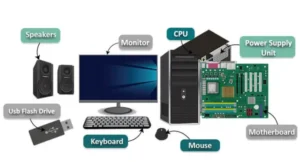Von Neumann architecture is a design for how computers operate. In 1945, John von Neumann first explained it. It forms the basis of modern computers. This design employs the stored-program notion. That implies a computer can store instructions in memory and execute them as needed. A stored-program computer is adaptable. It can do a variety of functions. This design demonstrates how computers think and execute commands. It is a design for computer organization. Understanding it allows us to grasp why computers occasionally slow down. It also allows us to improve them in the future.
What is Von Neumann Architecture?
Berkeley system is another name for von Neumann architecture. It serves as a basis for most of modern electronic computers. It was first explained by John von Neumann in the EDVAC Report’s First Draft. It drove the growth of early computers such as the ENIAC, EDSAC, and IAS machine. This design is intended to support broad-application computing. Many programs can be run on a computer with stored programs. The CPU, memory, and input/output devices all work together to power the computer. This structure allows for great flexibility. Knowing it allows us to learn how computers analyze data and obey commands. It is the fundamental blueprint for modern computers.
Basic Structure of Von Neumann Architecture

The basic structure of Von Neumann architecture depicts how a computer operates. It is split into four main parts: the CPU, memory, buses, and input/output devices. Each piece has a certain function. The CPU thinks and makes decisions. The memory unit is used to store directions and data. Buses are used to move data between sections. Input/output devices allow robots to interface with humans. This concept employs a shared memory system, making computers simpler and simple. Knowing this structure enables us to grasp how robots process information and complete tasks. It serves as a model for most current computers.
Central Processing Unit (CPU)
The CPU, or processor, is the brain of the computer. It controls all operations and processes instructions. A CPU has many parts to work efficiently. Its configuration affects CPU performance and speed. Modern computers use microprocessors or general-purpose processors. The CPU reads instructions, performs calculations, and sends results to memory or devices. It works very fast, following the CPU clock speed. This central processing unit manages everything a computer does. Understanding the CPU helps us know how computers think and make decisions. It is the key part of the Von Neumann architecture.
Registers
These are little bits of highly rapid data inside the CPU. They store data only while the CPU works. The program counter (PC), instruction register (IR/CIR), and accumulator (ACC) are all critical processor registers. The memory address register (MAR) and memory info register (MDR) facilitate the transfer of data to and from memory. All-purpose registers are used to store interim results. These small storage spaces allow the CPU to run swiftly without the need for slower memory. Knowing registers shows how the CPU safely handles instructions. Processor registers are critical to a computer’s speed and ease of use.
Arithmetic and Logic Unit (ALU)
The CPU has an arithmetic logic unit (ALU). It does arithmetic operations such as adding or subtracting. It also performs logic processes, such as comparing numbers and making decisions. The ALU solves problems using interim register results. The ALU executes all requests that require analysis. This device allows the CPU to process data and make choices. The CPU cannot complete tasks unless the ALU is present. Knowing the ALU allows us to fully comprehend how computers perform math and logic fast within the CPU.
Control Unit (CU)
The control unit (CU) manages the CPU’s functions. It transmits control signals to other sections of the CPU. Timing signals guarantee that instructions are performed accurately. The CU also decodes instructions and understands what each command implies. It manages the ALU, registers, memory, and I/O devices. This element acts like a conductor in an orchestra, ensuring that everything functions together. Without the control unit, the CPU cannot work correctly. Understanding the CU allows us to see how computers manage things step by step.
CPU Clock Speed
CPU clock speed indicates how quickly the processor functions. It is measured in gigahertz (GHz). Each CPU clock cycle enables the CPU to execute one instruction. Higher clock rates result in speedier performance, but they also generate more heat. CPU clock speed influences how quickly applications run. Faster clocks enable the CPU to handle several jobs in a shorter time. Understanding clock speed allows us to compare processors and their performance. It is a critical component in the efficient design and operation of computers.
Memory Unit
The flash drive keeps data as well as instructions in the same place. This makes coding easy and adaptable. Computers employ main memory, which is also referred to as major memory or RAM. Shared memory allows the CPU to easily access orders and data. Memory safety ensures that apps do not erase each other. A good memory unit boosts computer speed. Understanding the memory unit reveals how systems store and retrieve info.
Memory Hierarchy
This structure classifies memory into tiers. DRAM main memory is fast and used for running programs. Flash memory can store data even when the machine is turned off. High Speed Memory (HBM) is very fast and aids in high-end activities. Its layout enhances computer efficiency. Delays fall with faster memory at the top. Knowing the memory hierarchy shows how computers balance speed and storage.
Caches
Caches are small, high-speed memory blocks within the CPU. L1 cache includes both an instruction cache (L1i) and a data cache (L1d). L2 and L3 caches are larger, but slightly slower. Caches contain frequently used instructions and data. This allows the CPU to access information more quickly without waiting for main memory. Using CPU cache boosts performance and efficiency. Understanding caches demonstrates how computers may eliminate delays and perform programs faster.
Buses in Von Neumann Architecture
Buses are paths that connect the CPU, memory, and I/O devices. They’re like paths inside the computer. Shared busses allow numerous parts to link up. The system bus consists of address, data, and control lines. Good bus design increases velocity. Understanding buses reveals how cpus move information cheaply.
Data Bus
The data bus transports actual data between the CPU, memory, and peripherals. Bus width and speed influence how quickly data travels. A bigger bus can transport more items at once. A quicker bus reduces processing times. Understanding the data bus allows us to comprehend how computers move data quickly.
I/O Bus
The I/O bus enables interaction among the CPU and the input/output devices. It is often part of the shared bus system. This bus allows keyboards, monitors, and other devices to pair with the CPU. A good I/O bus improves the overall system efficiency.
Bus Width and Speed Increases
High bus and memory capacity speeds up devices. PCIe bus design allows more rapid interaction between components. Faster buses enable the CPU to access memory and devices without waiting. Knowing bus speed shows how computers increase speed.
Input/Output Devices
Input/output devices enable people to interact with computers. Input devices, such as keyboards and mice, transmit data to the CPU. Output devices such as screens and printers display results. These devices are connected via input/output interfaces. Understanding I/O devices reveals how computers interact with the outside world.
I/O Controller
The I/O controller is responsible for managing devices such as disk drives, USBs, and network interfaces. It transfers and receives data between the CPU and the devices. Without controllers, devices cannot function properly. Controllers ensure that I/O communication runs smoothly and quickly.
External Devices
External devices consist of hard disks, solid-state drives (SSD), and display controllers. They store data, display results, and connect computers to the outside world. These gadgets are required to use a computer efficiently. Understanding external devices teaches us about how computers interact with people and other machines.
How Von Neumann Architecture Works

Von Neumann architecture works by allowing the CPU to follow a specific blueprint. Data and instructions are kept in memory. The CPU reads instructions, comprehends them, and executes tasks. This causes the computer to perform like a very quick office worker. The CPU, memory, and input/output devices all function together. Data travels via buses to reach the CPU. The Control Unit and ALU assist the CPU in processing instructions. The speed with which the CPU and memory operate has an impact on performance. Learning this approach demonstrates how computers solve issues fast and efficiently.
Fetch-Decode-Execute Cycle
The fetch-decode-execute cycle is how the CPU executes orders. First, it retrieves the instruction from memory. Then it decodes it so it knows what to do. It then performs what is needed to finish the task. This cycle occurs quite quickly. Each one proceeds through the fetch, decode, and execute steps successively. This serial execution ensures computer reliability and order. The instruction cycle keeps the CPU working all the time. Knowing the cycle shows how computers process orders step by step. It is the heart of Von Neumann’s architecture.
Data Flow and Performance Metrics
Data flow depicts how information moves within a computer. The speed at which instructions are executed is determined by the processor. If the CPU or RAM is slow, tasks will take longer. Memory transfer speed influences how fast instructions reach the CPU. Efficiency can be measured using performance measures. Computers that have quicker CPUs and memory do jobs more quickly. Understanding data flow allows us to see where delays occur. Efficient data flow keeps applications running smoothly. Von Neumann architecture employs these concepts to manage instructions. This allows computers to work faster and smarter.
Responsibilities of the CPU
The CPU serves a variety of tasks. It fits to the instruction set architecture (ISA). It works with fixed or long opcode. It handles both simple and complex inputs. Cycles per instruction (CPI) indicates how many steps an instruction takes. The CPU picks which task to complete first and analyses data. Its primary function is to fetch, decode, and execute orders. Knowing this role explains how the CPU keeps the computer running. It is the primary part of the Von Neumann design, managing all processing.
The Purpose of Control Unit and ALU
The Control Unit and ALU work inside the CPU. The Control Unit provides signals and controls instruction flow. It makes sure the orders run in the correct order. The ALU does operations like as addition, subtracting, and comparison. They work together to efficiently execute words and access memory. It also allows the CPU to solve problems quickly. Knowing the control unit and the ALU shows how pcs process tasks. All of them are critical to make Von Neumann architecture run easily and reliably.
Advantages and Limitations of Von Neumann Architecture

Von Neumann architecture is basic and flexible. The program storage notion allows machines to quickly save and run orders. Systems are modular, making design easier. Programs can be modified for various purposes. The CPU and memory work more efficiently together, causing rapid computation. The majority of current systems are built around that design. However, it has limits. Memory delay can reduce performance. Throughput can be reduced due to data transport delays and the Von Neumann bottleneck. Knowing the positive and negative aspects allows us to create better, more efficient devices.
Capabilities of Von Neumann Architecture
Von Neumann architecture has multiple benefits. Computers can run an array of apps thanks to their flexibility and range. Reliable systems allow you to alter tasks with no modifications to hardware. The flexible system design makes the system’s basis basic. Hardware reduction saves money and makes care easier. A faster machine allows you to finish things fast. These qualities make it right for everyday computing. It works nicely with desktops, laptops, and servers. Having all of this shows why the Von Neumann style is useful. Its simple, flexible, and quick design enables developers and engineers to effectively and safely build a wide range of systems for computers.
Design Limitations
Von Neumann architecture does have certain drawbacks. The Von Neumann barrier causes the CPU to run slowly because it can only access one program or data at a time. Memory latency can cause delays in processing data, slowing down programs. Delays in data transfer can impede speed, especially as huge amounts of data are sent. All of these issues have an impact how well you do overall. While the concept is easy, these limits show why some current computers have other designs. Knowing these design limits allows engineers to identify ways to make devices run more effectively and quickly.
Self-Modifying Code
The Von Neumann architecture allow software to change itself while running. This self-editing code can be useful since programs can change their behavior as needed. However, it carries risk. self-editing programs may become unstable or produce unforeseen mistakes. This can cause bugs or security issues. Knowing self-modifying code allows writers to utilize it carefully. It shows both the versatility as well as the perils of modern design. When utilizing this feature in software creation, it is critical to use proper control and testing.
Security Problems
Storing data and instructions together can cause security issues in Von Neumann design. Malicious code can be inserted to memory, leading to hacking attacks. Buffer overflow attacks occur when software write more data than memory can handle. Control systems for access must exist to secure data and instructions. Without guarding, these threats might cause system issues or allow hackers to gain control. Knowing these security issues enables engineers to develop safer computers. Risks can be reduced through careful design and efficient software practices. The Von Neumann design is powerful, but security should always be regarded.
Final Thought
The Von Neumann architecture is the basis for modern computing. The value of the stored-program notion affects how current computers operate. This design enables computers to store both instructions and data in the same memory. It made writing easier and more flexible. With obstacles such as the Von Neumann bottleneck, it remains highly important. Its design has served as a model for several new computer systems. Some recent systems seek to deviate from Von Neumann’s method in order to make computers faster and safer. Knowing Von Neumann architecture explains why it is a vital part of computers history and why it is still relevant today.
Frequently Asked Questions (FAQs) about Von Neumann Architecture

What is the Von Neumann Architecture?
The Von Neumann paradigm uses a stored-program architecture. Data and instructions share memory. This makes computers adaptable and simple to program. Programs may be reused and modified fast.
How does the processor function in Von Neumann Architecture?
The central processing unit (CPU) works by order processing. It does routine processing with the fetch-decode- execute cycle. The CPU computes, stores data, and ensures that tasks get done in order.
What are the main components of Von Neumann Architecture?
Memory cells, data buses, and input/output devices are the key elements of the Von Neumann system. They join. The CPU properly reads code, saves data, and talks with various parts.
How does memory work in Von Neumann vs Harvard Architecture?
Von Neumann shared memory for information as well as commands. Harvard architecture, or an altered Harvard design, uses a dual memory system for dividing them. Separate memory enables for faster access and better performance.
Why is the stored program concept important?
The stored-program approach provides flexibility for stored programs. Programs are easily reused and modified. This makes computers smarter and more capable of handling a wide range of tasks without the need for hardware upgrades.
What role does the data bus play?
The data bus is a component of the communication system. It transfers data between the CPU, memory, and I/O devices. A shared bus allows all sections of the computer to communicate efficiently.




